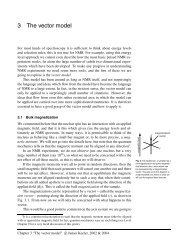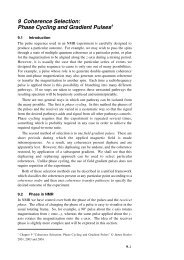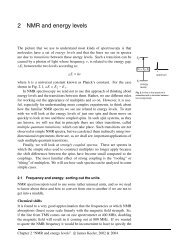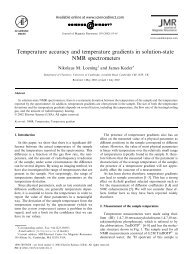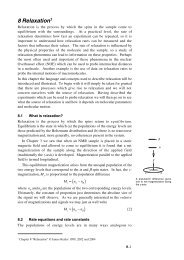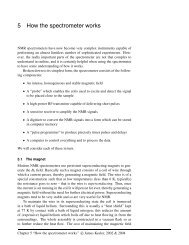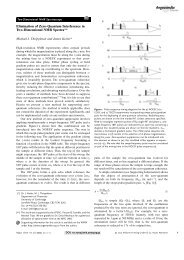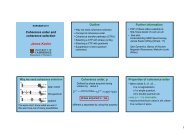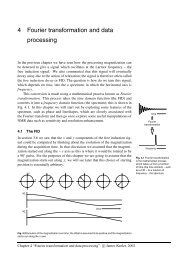Chapter 6: Product operators - The James Keeler Group
Chapter 6: Product operators - The James Keeler Group
Chapter 6: Product operators - The James Keeler Group
- No tags were found...
You also want an ePaper? Increase the reach of your titles
YUMPU automatically turns print PDFs into web optimized ePapers that Google loves.
( I I + I I )= ( I + iI )( I + iI )+( I −iI ) I − iI12 1+ 2+ 1− 2−[ ( )][ ]12 1x 1y 2x 2y 1x 1y 2x 2y1= 2 2I1xI2x + 2I1yI2ySo, the pure double quantum part of 2I 1xI 2xis 1 2 ( 2I1xI2x + 2I1yI2y); by a similarmethod the pure zero quantum part can be shown to be 1 2 ( 2I1xI2x − 2I1yI2y).Some further useful relationships are given in section 6.96.6 Three spins<strong>The</strong> product operator formalism can be extended to three or more spins. Noreally new features arise, but some of the key ideas will be highlighted in thissection. <strong>The</strong> description will assume that spin 1 is coupled to spins 2 and 3 withcoupling constants J 12and J 13; in the diagrams it will be assumed that J 12> J 13.6.6.1 Types of <strong>operators</strong>I 1xrepresents in-phase magnetization on spin 1; 2I 1xI 2zrepresents magnetizationanti-phase with respect to the coupling to spin 2 and 2I 1xI 3zrepresentsmagnetization anti-phase with respect to the coupling to spin 3. 4I 1xI 2zI 3 zrepresents magnetization which is doubly anti-phase with respect to thecouplings to both spins 2 and 3.As in the case of two spins, the presence of more than one transverseoperator in the product represents multiple quantum coherence. For example,2I 1xI 2xis a mixture of double- and zero-quantum coherence between spins 1 and2. <strong>The</strong> product 4I 1 xI 2xI 3zis the same mixture, but anti-phase with respect to thecoupling to spin 3. <strong>Product</strong>s such as 4I 1xI 2xI 3xcontain, amongst other things,triple-quantum coherences.6.6.2 EvolutionEvolution under offsets and pulses is simply a matter of applying sequentiallythe relevant rotations for each spin, remembering that rotations of spin 1 do notaffect <strong>operators</strong> of spins 2 and 3. For example, the term 2I 1xI 2zevolves underthe offset in the following way:Ω1tI1z Ω2tI2z Ω3tI3z2I I ⎯⎯⎯→⎯⎯⎯→⎯⎯⎯ →cosΩt 2I I + sin Ω t 2I I1x2z1 1x 2z 1 1y 2z<strong>The</strong> first arrow, representing evolution under the offset of spin 1, affects only thespin 1 operator I 1 x. <strong>The</strong> second arrow has no effect as the spin 2 operator I 2zandthis is unaffected by a z-rotation. <strong>The</strong> third arrow also has no effect as there areno spin 3 <strong>operators</strong> present.<strong>The</strong> evolution under coupling follows the same rules as for a two-spinsystem. For example, evolution of I 1 xunder the influence of the coupling to spin3 generates 2I 1 yI 3z2πJ tI zIzI ⎯⎯⎯⎯ 13 1 3 →cosπJ t I + sinπJ t 2 I I1x13 1x 13 1y 3zFurther evolution of the term 2I 1 yI 3zunder the influence of the coupling to spin 2generates a double anti-phase termJ 13J 12Ω 1α α β β spin 2α β α β spin 3<strong>The</strong> doublet of doublets fromspin 1 coupled to two otherspins. <strong>The</strong> spin states of thecoupled spins are alsoindicated.I 1x2I 1xI 2z2I 1xI 3z4I 1xI 2zI 3zRepresentations of differenttypes of <strong>operators</strong>.6–13



